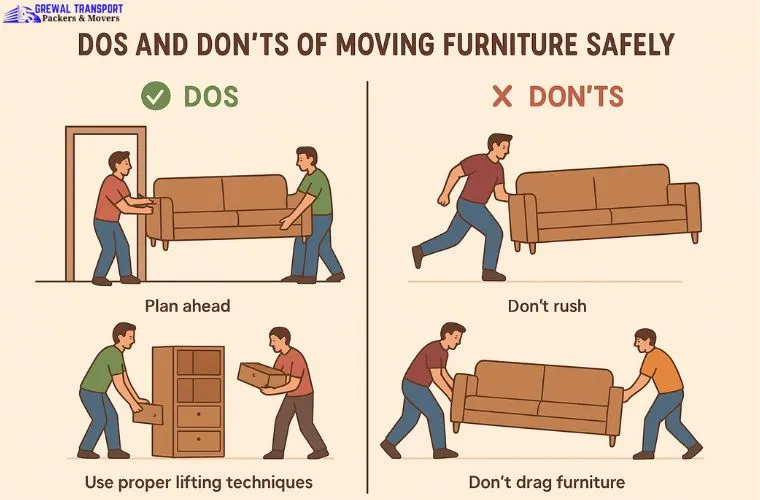Moving furniture is one of the toughest parts of relocating. Large wardrobes, sofas, dining tables, and beds can easily be damaged or cause injuries if incorrectly handled.
Whether planning a DIY move or hiring professionals, understanding what to do-and what to avoid-can protect your belongings and make the entire process smoother. Here's a practical guide to the dos and don'ts of furniture shifting safely without stress.
1. Pre-Move Planning: Start Smart
✔ Do Measure Before You Move: Measure doorways, staircases, and hallways to ensure furniture fits without getting stuck. Proper preparation prevents scratches and damage.
❌ Don't Assume Everything Will Fit: Guesswork can cause damage to property and injuries.
2. Break It Down to Make It Easy
✔ Do Disassemble When Possible: Remove detachable parts like table legs, shelves, headboards, or cushions. Pack screws and small components in labeled zip bags.
❌ Don't Keep Heavy Furniture Intact: Moving bulky items whole increases injury and damage risk. Break into sections for safer transport.
3. Protect Surfaces and Corners
✔ Do Use Wrapping Materials: Furniture blankets, bubble wrap, stretch film, and corner protectors safeguard surfaces. Foam sheets protect glass and polished areas.
❌ Don't Use Thin Bedsheets or Newspapers: Low-quality wrapping can tear, leaving furniture exposed to damage.
4. Lift the Right Way - Your Body Will Thank You
✔ Do Bend Your Knees, Not Your Back: Lift using legs, keep your back straight, and avoid twisting. Use sliders or dollies when available.
❌ Don't Lift Alone: Heavy pieces require assistance. Always have help to prevent accidents.
5. Keep the Pathway Clear
✔ Do Prepare the Space: Remove obstacles, rugs, or spills that could cause slips while moving furniture.
❌ Don't Drag Furniture on Floors: Dragging scratches floors and can damage furniture legs. Lift or use sliders/coasters instead.
6. Use Equipment the Right Way
✔ Do Take Advantage of Moving Tools: Hand trucks, forearm straps, moving blankets, and trolleys reduce effort and increase safety.
❌ Don't Overload Equipment: Exceeding weight limits can damage furniture or cause accidents.
7. Load Properly for Transport
✔ Do Secure Everything Inside the Vehicle: Use ropes, straps, or bungee cords to prevent sliding. Place heavy items at the bottom and light ones on top.
❌ Don't Stack Items Randomly: Unbalanced stacking can lead to tipping and breakage. Secure placement is always better.
8. Take Extra Care With Glass and Delicate Items
✔ Do Label Fragile Pieces Clearly: Mark glass tables, mirrors, or cabinets for careful handling.
❌ Don't Pack Fragile Items With Heavy Furniture: Separate fragile items and wrap with cushioning to prevent damage.
9. Use Professional Help When Needed
✔ Do Hire Movers for Large or Expensive Pieces: Professional teams use proper techniques and tools for oversized items.
❌ Don't Try Risky Moves Yourself: Pianos, glass cabinets, or modular beds should not be moved without expertise.
10. Make Unloading and Unpacking Organized
✔ Do Place Furniture Strategically: Plan furniture placement before unloading to avoid multiple lifts.
❌ Don't Rush Unpacking: Remove protective wraps carefully to avoid scratches or damage.
✅ Bonus Tips for Smooth Furniture Moving
- Wear gloves for a better grip.
- Label dismantled parts clearly.
- Use cardboard on floors for extra protection.
- Lift in pairs instead of pushing.
- Keep toolkits handy for assembly.
- Avoid moving during wet or unsafe conditions.
Final Thoughts
Moving furniture safely takes planning, patience, and the proper techniques. From wrapping and disassembling to lifting and loading, every step matters.
Whether relocating with Grewal Transport Packers and Movers or planning a DIY move, following these dos and don'ts ensures your furniture stays damage-free and your move remains stress-free. A little preparation today can save costly repairs tomorrow. Move smart, not hard!




